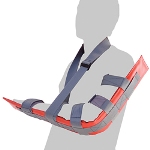 Classification of bone fractures
Classification of bone fractures

A bone fracture is a partial or complete violation of their anatomical integrity, accompanied by damage to surrounding tissues and impaired function of the injured segment.
The modern classification of bone fractures is diverse and is based on many factors.
Determining the type of fracture plays an important role in how correctly first aid will be provided, especially at the prehospital stage.
Classification of bone fractures by origin
- Congenital fractures - occur in utero, due to the imperfection of the integrity of the skeleton of the fetus. Obstetric fractures can be considered conditionally congenital, occur during pathological childbirth.
Signs of congenital fractures are similar to those acquired, and first aid for them is the same. There is only slight pain or its complete absence.
- Acquired fractures - can be traumatic (due to mechanical impact on a healthy bone) and pathological (as a result of painful processes in the bone - osteomyelitis, bone tumors, fibrous dysplasia, tuberculosis, metastases, etc.).
Depending on the integrity of the skin
- Closed - without damage to the skin.
Closed fractures can be:
- complete - with a violation of the integrity of the entire bone;
- incomplete - if the integrity of the entire bone is not broken, as in the case of tearing of tubercles of bones, marginal fractures.
- Open fractures occur when the integrity of the skin is broken.
- Primary open - the skin is damaged by a traumatic agent.
- Secondary open - soft tissues and skin are damaged from the inside by bone fragments.
By severity of damage
- Simple fractures - with a violation of the integrity of one bone.
- Complicated - with a violation of the integrity of two or more bones, dislocation, damage to the ligaments, joint capsule.
In the direction of the fracture plane
- Longitudinal.
- Transverse.
- Oblique.
- Helical.
By the presence of displacement of fragments:
- Fractures of bones without displacement of bone fragments.
- Displaced fractures:
- with primary displacement - occurring at the moment of fracture under the influence of a traumatic force;
- with a secondary displacement - arising after a fracture during the contraction of skeletal muscles.
By type of displacement of fragments
- By lenght.
- By width.
- At an angle.
- Rotary.
- Combined - if 2 or more types of displacement (for example, at an angle and rotational).
According to the localization of damage to the tubular bones:
- diaphyseal - a fracture in the diaphysis of the bone;
- metaphyseal - periarticular, in the area where the spongy substance is located, often impacted;
- epiphyseal - intra-articular, with a rupture of the articular bag and displacement, are called fracture-dislocations.
Depending on the development of complications:
- uncomplicated;
- complicated.
Complications of bone fractures
- Damage to blood vessels - various types of bleeding, pulsating hematoma.
- Damage to the nerve trunks - paresis, paralysis.
- development of traumatic shock.
- Fat embolism in the bone marrow.
- Damage to the integrity of vital organs - the heart, lungs, brain.
- Damage to internal organs.





